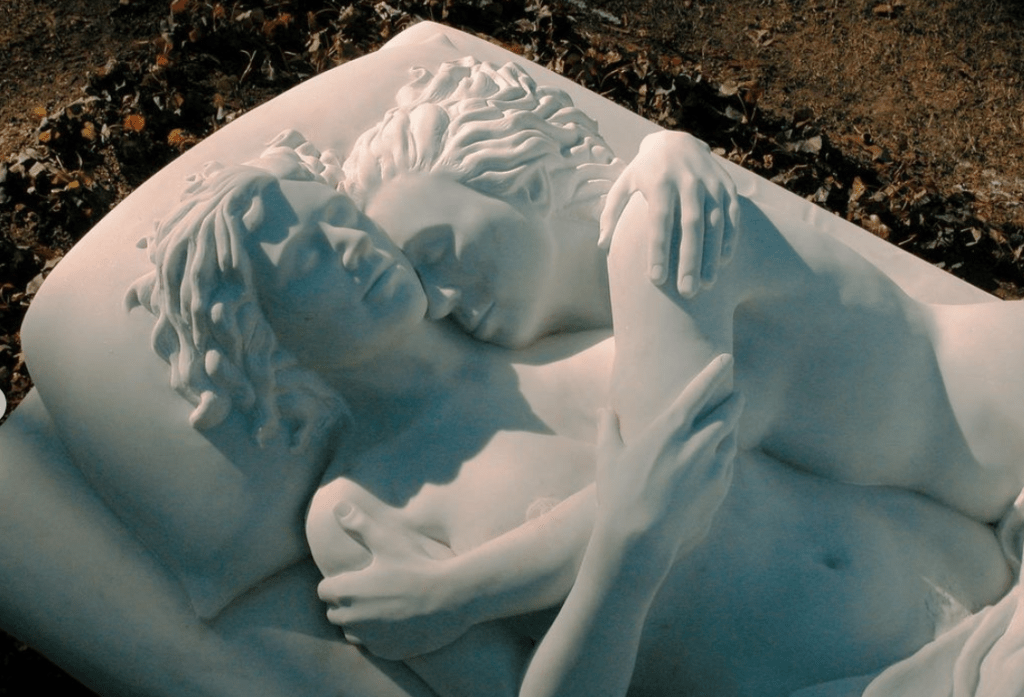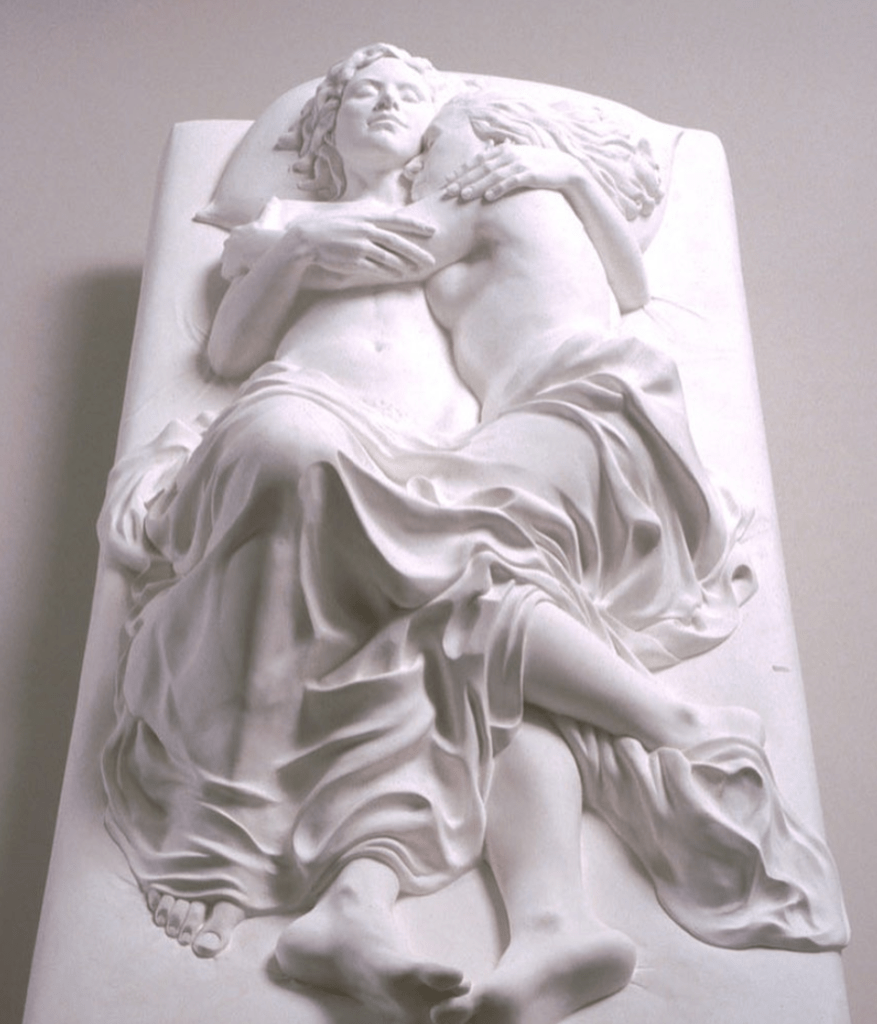Almost 20 Years of Patricia Cronin’s Memorial To A Marriage

2022 will commemorate the 20th anniversary of Patricia Cronin’s Memorial To A Marriage (2002). “The first and only Marriage Equality monument in the world,” made with three-ton Carrara Marble, is a mortuary sculpture of Patricia Cronin and (now) wife, artist Deborah Kass. The life-partners entwine on a bed, expressing their love and commitment in a pure, affectionate embrace.
Patricia Cronin created the artwork before same sex marriage was legal in the U.S. “To simulate a few of the 1200 rights heterosexual marriage affords, homosexual couples could only acquire legal documents about the end of their lives, such as wills, health care proxies and powers of attorney documents,” according to Patricia Cronin’s website. “Employing the American Neo-classical sculptural form to address a federal failure of prohibiting same sex couples to legally wed, she purchased their burial plot in Woodlawn Cemetery, Bronx, NY a National Historic Landmark, and permanently installed the statue on their future final resting place.”
“Memorial To A Marriage (2002) has been exhibited in over 50 exhibitions in the United States and abroad, including Brooklyn Museum, Brooklyn, American Academy in Rome, Rome, Italy, The FLAG Art Foundation, New York, Gallery of Modern Art, Glasgow, Scotland, Tampa Museum of Art, Tampa, FL, and Newcomb Art Museum, Tulane University, New Orleans, among others.”
Marriage’s symbolism
The touching artwork depicts the transcendental, spiritual, life-long committed, “‘til death do we part” type of love that lesbians can experience. It depicts why we should have the right to get married: the love we share is no less genuine or permanent than a straight couple. We don’t necessarily have different goals, hopes or dreams for our relationships. We deserve the 1200 couple rights marriage affords.
The “neo-classical sculpture” commemorates same-sex love in a similarly respectable, solid, permanent way humans have historically heroicised heterosexual love and figures through statues. Like marriage, the sculpture is far from fleeting. When Patricia Cronin and Deborah Kass are laid to rest with the sculpture, illustrating their love’s durability beyond death, passers-by will have a moment to consider lesbianism’s sincerity and continuity. It’s hard to “other” when presented with something so authentic and touching.
Patricia Cronin depicts dual sexual and romantic connection between women in Memorial To A Marriage. When Patricia and Deborah weren’t legally allowed to wed, this artwork honoured an enduring love that might never have been remembered or recorded otherwise. Patricia chose to represent their relationship honestly. The women are naked in bed, indicating a sexual connection, and they’re sweetly embracing, indicating romance. This isn’t a common way of depicting lesbians: we’re often either desexualised or fetishised. There’s usually no in between.
Patricia made sure there was no option for future historians to mistake the pair as “gal pals.” Unlike many lesbians from history, Patricia and Deborah are unquestionably portrayed as wives in Memorial To A Marriage. Now that they are legally wed, the memorial is to their legal marriage as well as the commitment made long before.

Bringing back “ordinary”
Memorial To A Marriage‘s classical form normalizes same-sex love. Instead of viewing lesbianism as “queer,” a fetish for the entertainment of men, or a fleeting fad, Memorial To A Marriage represents the delightful, natural ordinariness of many same-sex couples.
“What is it that makes most viewers double take when they encounter this sculpture?” Laura Bauld wrote for Art UK. “The figures lying intimately together are both women. The reason that viewers stop in their tracks is, more often than not, because their unconscious, heteronormative bias has been momentarily disrupted. In a sculpture of such inherent classical form, they expect to see a man and woman lying together. Instead, they are confronted with something quite different from their expectations.”
A bronze sculpture of Memorial To A Marriage is kept at Glasgow’s Kelvingrove Art Gallery and Museum. “I have seen this reaction again and again while taking visitors around the halls of Kelvingrove or even just people-watching,” Laura continued. “For this sculpture was made to provoke a reaction. It was created to challenge and confront heteronormativity, bias, and LGBTQ+ discrimination. Every double take proves the power of this sculpture.”
As much as I agree that the sculpture provokes a reaction, I don’t believe that was its most notable purpose. When a same-sex couple walks hand in hand down the street, they do so because they’re expressing their love. They don’t do it to provoke a reaction. Reactions happen because of homophobia.
I feel the same about Memorial To A Marriage. I see an expression of love first. I see the artist wanting to commemorate a sexual, romantic, life-long love that — especially pre-same-sex marriage — might not have been recorded with the appropriate weight without it. For some of us, a marriage is just that: a historical record of how meaningful our relationship is and was.
Same-sex couples still aren’t viewed as equal. For example, “Although the Supreme Court struck down the Defense of Marriage Act in 2013, making the United States the 29th country in the world, out of 195 countries, legally recognizing same sex marriage, homosexuality is still illegal and punishable up to death in 27 countries,” according to Patrica Cronin’s website. “This is still a major international human rights issue.”
Same-sex marriage didn’t end homophobia, even in the U.S. However, we can still count our blessings. Marriage gave same-sex couples 1200 rights the legal commitment affords. Marriage is an important record. When we are dead and gone, our relationships will be traced with the significance they deserve through marriage.





